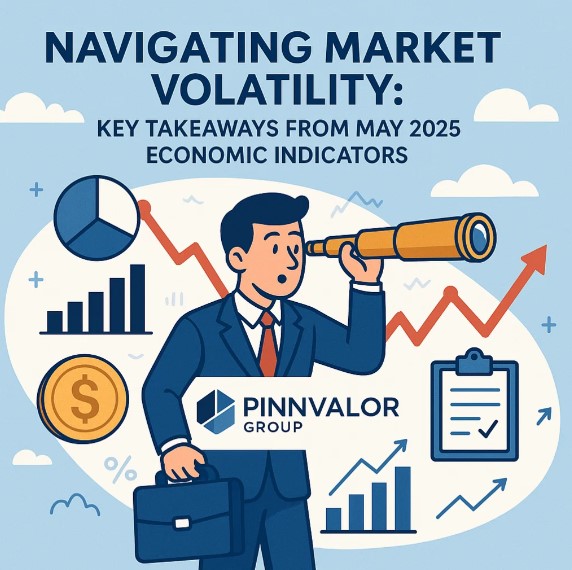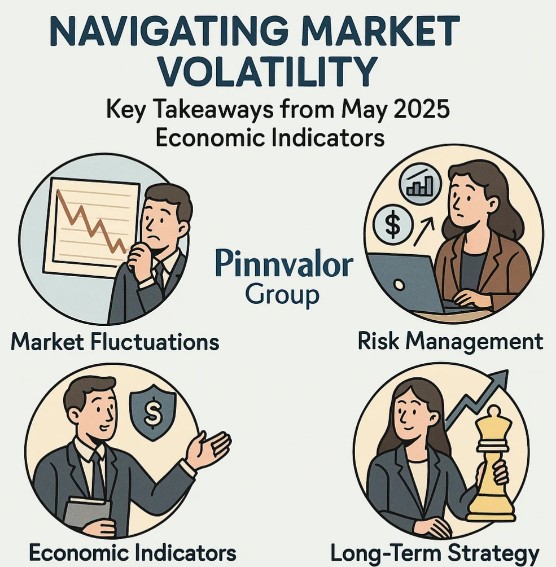
Navigating Market Volatility: Key Takeaways from May 2025 Economic Indicators
The global economic landscape in May 2025 is characterized by heightened market volatility driven by a mix of geopolitical uncertainties, shifting economic policies, and evolving market dynamics. As investors grapple with these fluctuations, it becomes critical to understand the key indicators influencing market sentiment. This blog delves into the factors driving this volatility and provides insights into potential strategies for navigating this turbulent environment.
How can investors navigate the current market volatility and safeguard their portfolios in 2025?
In times of market volatility, diversification is your shield, and informed decision-making is your sword. The more you understand the economic landscape, the better you can position your investments for long-term growth.
🌍 Global Economic Landscape: Key Economic Indicators
U.S. Economic Indicators:
- Trade Policy Uncertainties: The United States has reintroduced tariffs on several countries, including China, affecting global trade relations. While some tariff increases have been temporarily paused, the policy remains uncertain. The uncertainty surrounding these tariffs raises concerns about the long-term implications for global supply chains and market stability. These concerns are compounded by ongoing trade negotiations and their potential to influence market sentiment.
- Federal Reserve’s Stance on Interest Rates: The Federal Reserve has maintained its interest rate policy despite growing concerns over inflation and economic stagnation. The Fed’s decision to hold rates steady is part of its broader strategy to assess the effects of its previous rate hikes. However, there is growing concern that persistently high inflation coupled with high unemployment could result in a stagflationary environment. The central bank’s cautious approach suggests a prolonged period of uncertainty for investors.
Indian Economic Outlook:
- GDP Growth Projections: Moody’s revised India’s GDP growth forecast for 2025 to 6.3%, down from an earlier projection of 6.5%. The revision reflects a range of factors including global trade uncertainties, rising oil prices, and geopolitical tensions in the region. The IMF has also highlighted concerns about inflationary pressures and slowdowns in domestic consumption as potential risks to sustained economic growth.
- Market Volatility: India’s stock market, represented by indices like the Nifty and Sensex, has seen increased volatility as the India VIX (Volatility Index) surged by 7%. This surge is attributed to both domestic factors like political uncertainty and external pressures, including ongoing tensions with neighboring countries. A more volatile market requires investors to rethink their portfolio strategies to avoid undue risks during uncertain times.

📉 Market Dynamics: What’s Driving the Volatility?
- Equity Markets: Despite the volatility, equity markets have shown resilience in the face of rising tensions. The S&P 500 has continued to make gains after a temporary pause in tariff hikes. However, there remains significant concern over the long-term impact of trade policies on corporate earnings. This is particularly relevant for sectors dependent on international supply chains, such as technology, automotive, and consumer goods.
- Bond Markets: The bond market has also reacted to the growing uncertainty, with U.S. Treasury yields rising. This signals that investors are increasingly concerned about inflation and the potential for further fiscal policy tightening. The rising yields indicate that bond investors are pricing in higher inflation expectations, and many are seeking safety in bonds, which are traditionally seen as a defensive asset class.
💡 Investment Strategies Amid Market Volatility
Investing in volatile markets requires a strategic approach that balances risk with the potential for return. Below are some strategies investors can adopt during this uncertain period:
- Diversification: Diversification remains one of the most effective strategies for managing risk during periods of market volatility. Investors should look to spread their investments across various asset classes (equities, bonds, real estate) and geographies. A diversified portfolio reduces the impact of volatility in any one market and provides greater stability in the long run.
- Focus on Defensive Sectors: Sectors that are less sensitive to economic cycles, such as utilities, consumer staples, and healthcare, tend to perform better during times of economic uncertainty. These sectors provide essential services that are in constant demand, regardless of economic conditions. As a result, they often experience less price fluctuation and can offer investors more stability during market downturns.
- Short-Term Fixed Income Investments: With interest rates expected to remain high for the near future, short-term fixed income securities may offer a safer alternative for risk-averse investors. These include short-term government bonds, corporate bonds with stable ratings, and money market funds. These instruments provide predictable returns and are less sensitive to interest rate changes than longer-duration bonds.
- Hedging Against Inflation: Inflation has been a key driver of market volatility, and as such, investors should consider hedging against inflation risks. Inflation-protected securities, such as Treasury Inflation-Protected Securities (TIPS), offer a way to safeguard against rising prices. Real estate, commodities (such as gold), and other tangible assets can also act as effective inflation hedges, providing potential protection against the eroding purchasing power of currency.
- Stay Informed on Economic Data: Continuous monitoring of key economic indicators is crucial in navigating market volatility. Inflation rates, employment figures, consumer confidence, and central bank policy decisions are all important data points that can impact market trends. By staying informed on the latest economic developments, investors can adjust their portfolios in real time to minimize risk.
🔍 Conclusion: Navigating Through Volatility
The economic indicators as of May 2025 point to a period of heightened uncertainty across global markets. While some sectors show resilience, the overall outlook remains volatile. Investors need to take a cautious yet proactive approach, leveraging diversification, focusing on defensive sectors, and keeping an eye on economic data. By implementing strategic risk management techniques and adjusting portfolios to reflect the current market environment, investors can navigate through the volatility and position themselves for long-term growth.
🌟 Final Thoughts
- Trade tensions, rising inflation, and shifting monetary policies will continue to shape the investment landscape in the coming months.
- Diversified portfolios and investments in defensive sectors remain key to managing risk.
- Economic indicators such as inflation rates and employment figures will be critical in shaping future market decisions.
Investors who remain informed, flexible, and diversified are more likely to weather the storm of market volatility in 2025. Stay ahead of the curve and adapt your strategies to safeguard your investments.
The blog was inspired by recent trends and developments in the U.S. and Indian economies, with insights into the broader global market factors shaping investor sentiment in 2025.
